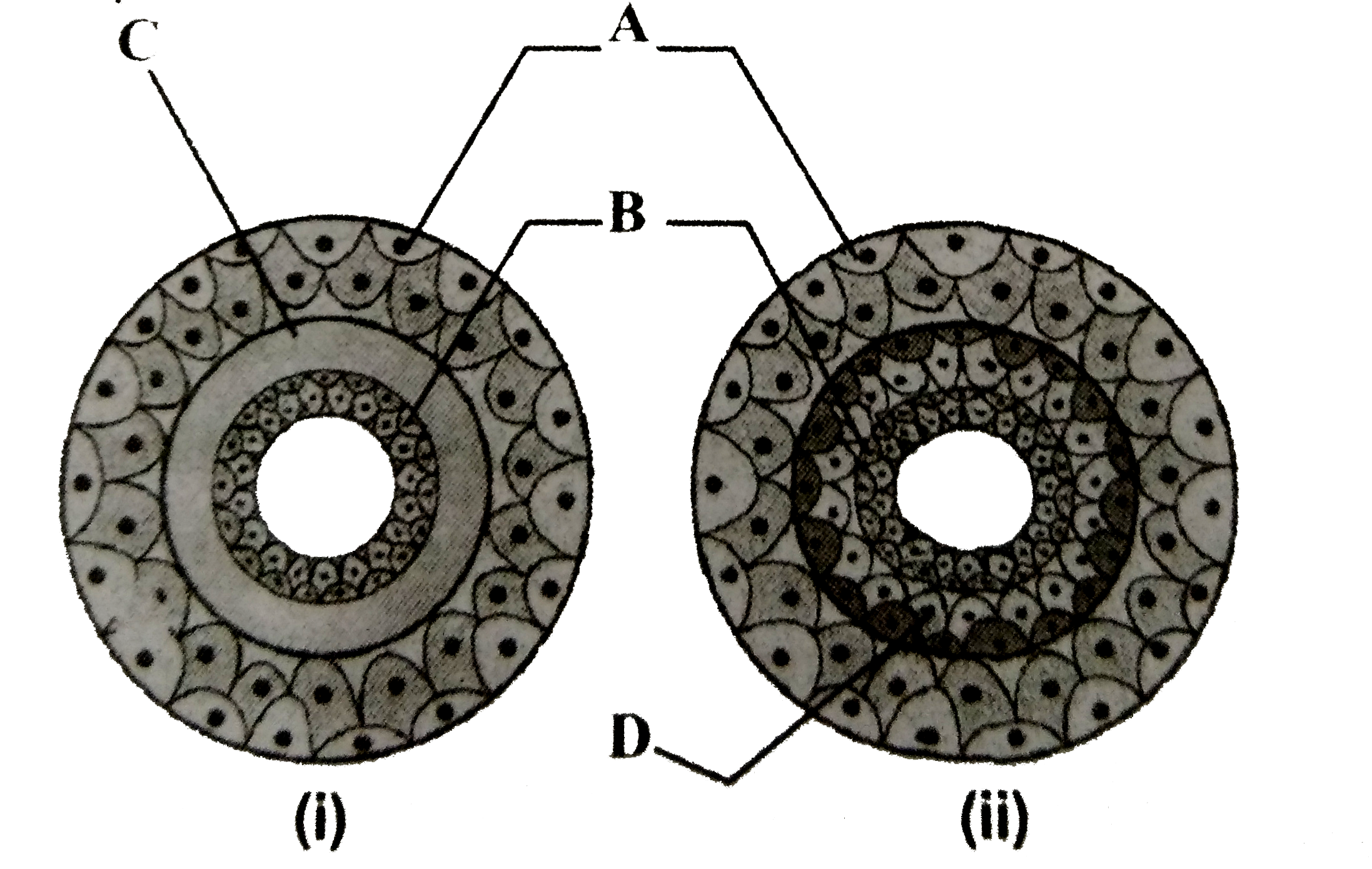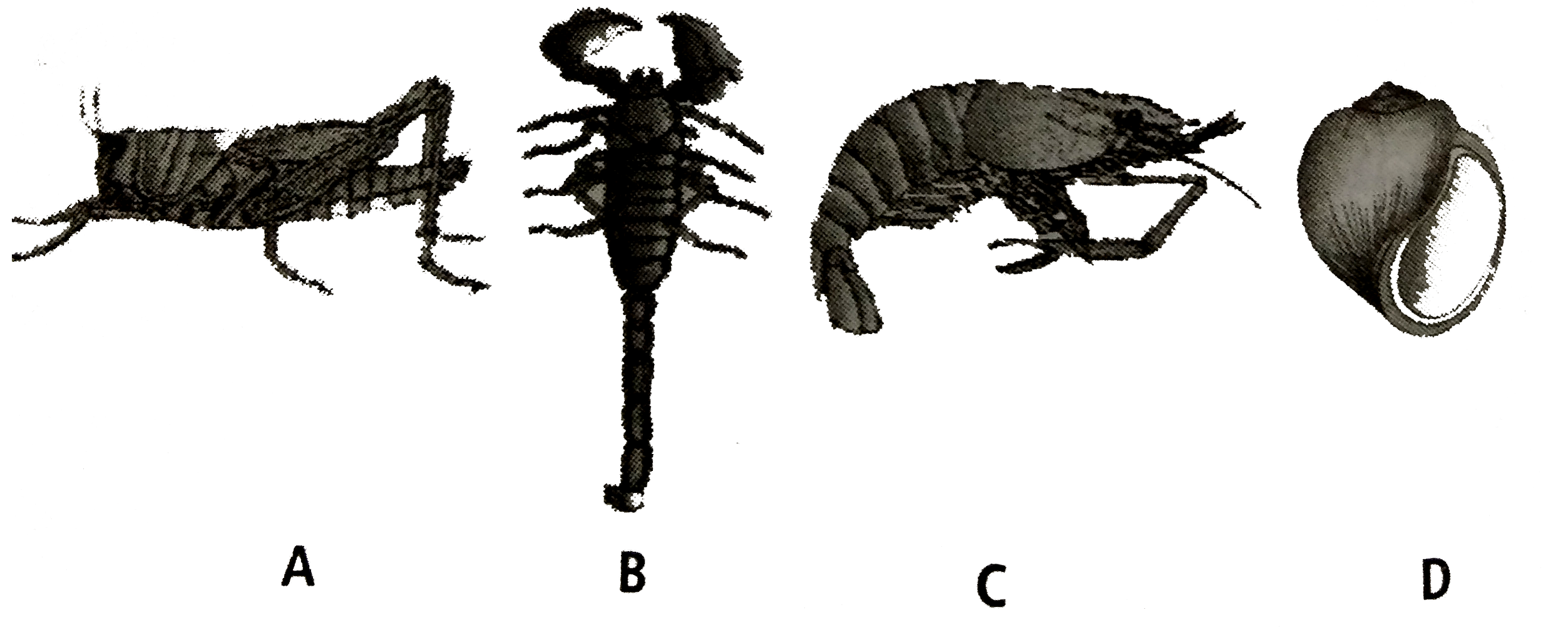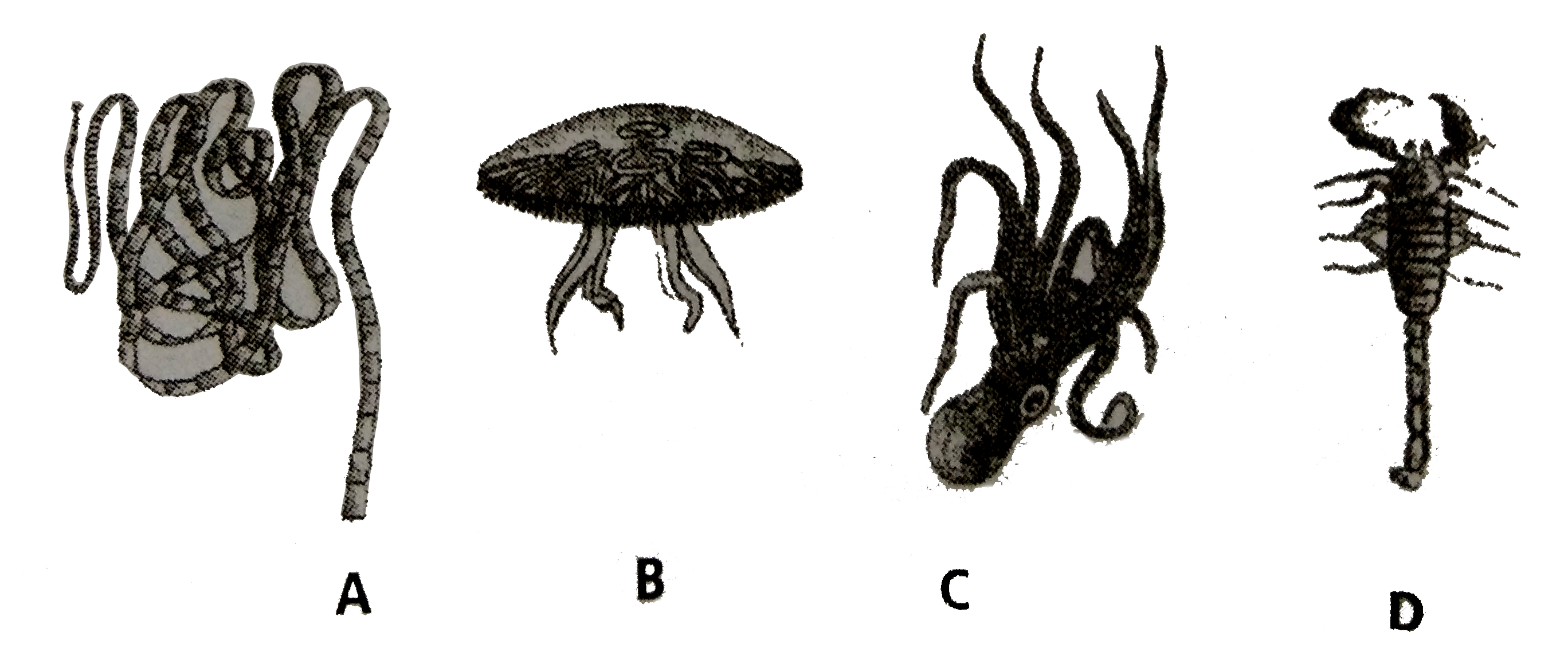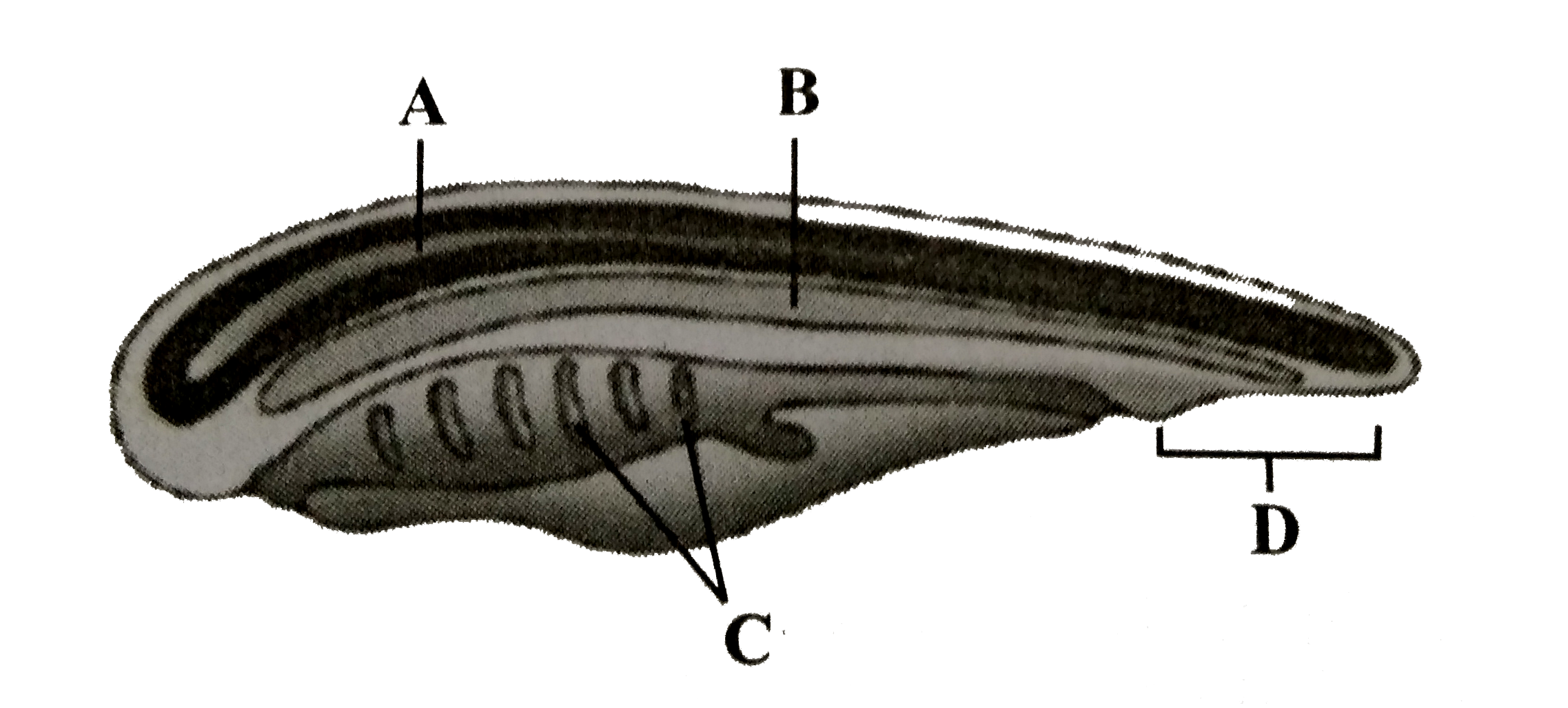Complete Solutions to Animal Kingdom of chapter ANIMAL KINGDOM of Class 11 book with complete answers and questions
| Class 11 | BIOLOGY |
| Chapter | ANIMAL KINGDOM |
| NCERT FINGERTIPS | Animal Kingdom |
| Number Of Questions | 100 |
| Academic Year | 2023-24 |
Which of the following statements is incorrect with regard to bilateral symmetry?
View SolutionIdentify type of symmetery in the given animals `A` and `B`.

View SolutionDiploblastic and triploblastic are terms that describe
View SolutionThe animals posseing the following type of germ layers (A and B) are called __________and_____respectively.

View SolutionExamine the figures of diploblastic (i) and triploblastic (ii) organisation in animals given below and identify the labelled parts A to D.

View SolutionThe figures given below show the types of coelom. Identify them and select the correct group of organisms which possess them.

View SolutionWhich of the following are correct?
`{:((i)"Diploblastic",:,"Poriferans, Coelenterates"),((ii)"Triploblastic",:,"Platyheliminthes to Chorodates"),((iii)"Acoelomate",:,"Poriferans,Coelenterates,Platyhelminthes"),((iv)"Pseudocoelomate",:,"Aschelminthes /Roundworms"),((v)"Eucoelomate",:,"Annelids to Chordates"):}`
View SolutionSelect the correct matching of animals, their symmetry, organisation and coelom type.
View SolutionThe given figures shown a cross section of the body of an invertebrate. Identify the animal which has such body plan.

View SolutionRead the given statements and select the correct option.
Statement 1: All triploblastic animals are eucoelomates.
Statement 2: They have a false correct.
View SolutionWhich of the following is correctly matched?
View SolutionStudy carefully the given flow chart and fill in the blanks (A), (B), (C), (D) and (E).

View SolutionIdentify the given figures A, B and C and select the correct option.

View SolutionIn the most simple type of canal system of Porifera, which of the following ways exhibit water flow?
View SolutionWhich of the following is not a characteristic feature of sponges?
View SolutionWhich is not correct for sponges?
View SolutionThe statements given below shows some characteristics of a phylum. Identify it.
(i) Tissue absent (ii) Internal fertilisation
(iii) Developments is indirect
(iv) Spongocelate with ostia (many) and single osculum and canal system
(v) Sexes are hermaphrodite.
View SolutionWhich of the following statements is correct for sponges without exception?
View SolutionWhich of the following is not a correct match of animal and its habitat?
View SolutionStinging capsules (nematocysts) are found in
View SolutionMatch the following and select the correct option from the codes gives below.
`{:(Column-I, Column-II),(A."Physalia",(i)"Sea anemone"),(B."Meandrina",(ii)"Brain coral"),(C."Gorgonia",(iii)"Sea fan"),(D."Adamsia",(iv)"Portuguese man of war" ):}`
View SolutionWhich of the following have porous body and are diploblastic?
View SolutionIdentify the figures A, B, C and D and select the correct option.

View SolutionThe characters given below are shown by
(i) Extracellular and intracellular digestion
(ii) Exclusively marine, radially symmetrical, diploblastic, tissue level of organisation
(iii) Bisexual, fertilisation external and indirect development
(iv) No asexual reproduction
(v) Presence of comb plates
View SolutionGiven below are three statements regarding Aschelminthes.
(i) They are bilaterally symmetrical and triploblastic.
(ii) They are dioecious.
(iii) All are plant or animal parasites.
Select the option that has both the correct statemets.
View SolutionIn which of the following, segmentation in the body is first observed?
View SolutionIdentify the figures A,B, C and D and select the correct option.

View SolutionMatch column I with column II and select the correct option from the given codes.
`{:(Column-I,Column-II),(A."Choancoytes", (ii)"Platyhelminthes"),(B."Cnidoblasts",(ii)"Ctenophora"),(C."Flame cells",(iii)"Porifera"),(D."Nephridia",(iv)"Coelenterate"),(E."Comb plates",(v)"Annelida"):}`
View SolutionConsider the following statements `(A-C)` each with two blanks.
A. Animals like Hydra and jelly fis depict `ul((i))` symmetry whereas earthworm and leech show `ul((ii))` symmetry.
B. In `ul((iii))` and `ul((iv))` digestive tract has only single opening (mouth) and is said to be incomplete.
C. Trichinella (Trichina worm) is a cosmopolitan `ul((v))` parasite whereas Fasciola (live fluke) lives in the bile ducts of the liver of `ul((vi))`
Which one of the following options, correctly fills any two statements?
View SolutionMatch column I with column II and select the correct option from the given codes.
`{:(ColumnI,ColumnII),(A."Protandry",(i)"Ovaries mature earlier than testes"),(B."Protogyny",(ii)"Testes mature earlier than ovaries"),(C."Metameric segmentation",(iii)"Scorpion"),(D."Radial symmetry",(iii)"Neresi"),(E."Book lungs",(iv)"Aurelia"):}`
View SolutionRead the given statements and select the correct option.
Statements 1: Blood is colourless in the insects.
Statement 2: Insect blood has no role in `O_(2)` transport.
View SolutionWhat is common between earthworm and Periplaneta?
View SolutionWhich of the followinf are examples of Arthropoda?
View SolutionAmong the following organisms which is a completely non-parasitic form?
View SolutionWhich one of the following features is common in silver fish,scorpion, dragonfly and prawn?
View SolutionWhat is common among crab and honeybee?
View SolutionHow do you differentiate a butterfly from a moth?
View SolutionWhat is true about Nereis, scorpion, cockroah and silver fish?
View SolutionIdentify the figures A, B ,C and D given below and select the correct option.

View SolutionRead the following statements and select the incorrect ones.
(i) Circulatory system in arthorpods is of closed type.
(ii) Parapodia in annelids help in swimming.
(iii) Phylum Mollusca is the second largest animal phylum.
(iv) Aschelminthes are dioecious.
View SolutionThe given figures `(A-D)` show four animals. Select the correct option with respect to a common characteristic of any two of these animals.

View SolutionWhich one of the following statements about certain given animals is corret?
View SolutionPhylum Mollusca can be distinguished from other invertebrates by the presence of
View SolutionFill up the blank spaces in the tabe below by selecting the correct option.
`{:("Phylum/Class","Excretory organ","Circulatory system","Respiratory organ"),("Arthropoda",A,B,"Lungs/Gills/Tracheal system"),(C,"Nephridia","Closed","Skin"),(D,"Methanephridia","Open",E):}`
View SolutionWhich one of the following is a matching set of a phylum and its three examples?
View SolutionWhich of the following is commonly called "pearl oyster" ?
View SolutionBilateral symmetry, segmentation, coelom and open circulatory system characterises which of the following phyla?
View SolutionYou have discovered an animal having characters like, triploblastic, bilateral symmetry, coelomate, chitinous exoskeleton, head, thorax and abdomen as body parts, and jointed appendages.
You should place the animal under
View SolutionWhich of the following statements are incorrec?
(i) Parapodia are lateral appendages in arthropods used for swimming.
(ii) Radula in molluscs are structures involved in excretion.
(iii) Aschelminthes are dioecious.
(iv) Echinoderm adults show radial symmetry.
(v) Ctenophorans are diploblastic
View SolutionIn which one of the following, the genus name, its two characters and its phylum are not correctly matched? `{:("Genus name","Characters","Phylum"),((d)"Periplaneta",(i)"Jointed appendages ","Arthropoda"),(,(ii)"Chitinous exoskeleton",):}`
View SolutionMatch the animal names listed under column I with the zoological names gives under column II and select the correct option from the gives codes.
`{:(ColumnI,ColumnII),(("Common name"),"(Zoological name)"),(A."Starfish",(i)"Sepia"),(B."Jellyfish",(ii)"Asterias"),(C."Devilfish",(iii)"Aurelia"),(D."Cuttlefish",(iv)"Octopus"),(,(v)"Hippocampus"):}`
View SolutionWhich one of the following groups of three animals is correctly matched with their one characteristic morphological feature?
View SolutionMatch column I with column II and select the correct option from the codes gives below.
`{:(Column I,Column II),(A."Hirudin",(i)"Hydra"),(B."Canal system",(ii)"Echinodermata"),(C."Nematocysts",(iii)"Leech"),(D."Feather star",(iv)"Sponges"),(E."Insects",(v)"Termites"):}`
View SolutionIdentify the animal (A) and name the phylum to which its belongs (B).

View SolutionWhich one of the following is a matching pair of a body feature and the animal possessing it?
View SolutionAnimals belonging to Phylum Chordata are fundamentally characterised by the presence of structures noted as A, B C and D. Identify them and select the correct option.

View SolutionWhich one of the following phyla is correctly matched with its two general characteristics?
View SolutionThe echinoderms, hemichordates and chordates had which of the following larve as a common ancestral form?
View SolutionCrocodile and penguin are similar to whale and dog fish in which one of the following features?
View SolutionRead the given statements and select the correct option.
Statement 1 : Urochordates and cephalochordates are often called invertebrate chordates.
Statement 2: They are a connecting link between the invertebrates and the chordates.
View SolutionRead the given statements and select the correct option.
Statement 1 : Cephalochordate bears notochord throughout their life.
Statement 2: In cephalochordates, notochord extends from head to tail.
View SolutionMatch column I with column II and select the correct option from the given codes.
`{:(Column I, Column II),(A."Cyclostomers",(i)"Hemichordata"),(B."Aves",(ii)"Urochordata"),(C."Tunicates",(iii)"Agnatha"),(D."Balanoglossus",(iv)"Pisces"),(E."Osteichthyes",(v)"Tetrapod"):}`
View SolutionWhich one of the following statements is incorrect about the occurrence of notochord ?
View SolutionIn some chordates, the notochord is modified as the vertebral column. Such animals are called vertebrates. Which one of the following statements makes sense?
View SolutionA common characteristic of all vertebrates without exception is
View SolutionGo through the following flow chart for division of subphylum vertebrate. Fill the graph A, B, C and D and select the correct option.

View SolutionMatch column I with column II and select the correct option from the gives codes.
`{:(Column I,Column II),(A."Wings",(i)"Reptiles"),(B."Operculum",(ii)"Chondrichthyes"),(C."Scutes",(iii)"Birds"),(D."Cartilaginous endoskeletion",(iv)"Osteichthyes"):}`
View SolutionMatch the excretory organs listed under column I with the animals given under column II and select the correct option.
`{:(Column I,Column II),("(Excretory organs)",("Animals")),(A."Nephridia",(i)"Hydra"),(B."Malpighian tubules",(ii)"Leech"),(C."Protonephridia",(iii)"Shark"),(D."Kidneys",(iv)"Roundworms"),(,(v)"Cockroach"):}`
View SolutionTo which classes do the following animals belong? A-Petromyzon, B-Scoliodon, C-Pristis
View SolutionWhich of the following is/are not the characteristics of the Class Osteichthyes?
(i) Body is streamlined and mouth is terminal.
(ii) Gills are convered by operculum.
(iii) Skin convered with cycloid and placoid scales.
(iv) Many of them are viviparous.
View SolutionSelect the correct option in respect of characteristics of each group.
`{:("Cyclostomes","Chondrichthyes","Osteichthyes"),((i)"Suking mouth","Ventral mouth","Terminal mouth "),((ii)"Scales absent","Placoid scales","Cycloid/Ctenoid scales"),((iii)"Marine","Marine","Marine adn freshwater"),((iv)6-15"pairs of gills",5-7 "pairs of gills without operculum",4 "pairs of gills with operculum"):}`
View SolutionMatch column I with column II and select the correct option from the gives codes.
`{:(A."Cartilaginous fishes",(i)"Usually external fertilisation"),(B."Bony fishes",(ii)"Internal fertilisation"),(,(iii)"Mostly oviparous"),(,(iv)"Mostly viviparous"),(,(v)"Direct development"):}`
View SolutionThe figure of Labeo rohita is given below. Identify the parts labelled as A, B,C, D and E.

View SolutionWhich of the following is a correct match?
View SolutionWhich of the following group is formed of only the hermaphordite organisms?
View SolutionWhich of the following statements is/are correct or incorrect regarding Class Amphibia?
(i) Body is divisible into head and trunk. Tail is present in some amphibians.
(ii) Show respiration by gills, lungs and through skin.
(iii) Has scales in all its members.
(iv) Can lead dual life (aquatic and terrestrial)
(v) Has eyelids.
View SolutionRead the give statements and select the correct option.
Statement 1 : Amphibians often hibernate in winter and aestivate in summer.
Statement 2 : They are poikilothermic animals and cannot regulate body temperature.
View SolutionThe limbless amphibian is
View SolutionIdentify the given animal.

View SolutionIdentify the following animals and the classes to which they belong.

View SolutionMatch the columns and select the correct option.
`{:(Column I,Column II),(A."Octopus",(i)"Limbs"),(B."Crocodile",(ii)"Comb plates"),(C."Catla",(iii)"Arms"),(D."Ctenoplane",(iv)"Fins"):}`
View SolutionAmphibians share with reptiles all of the following characters except
View SolutionWhich one of the following is a matching pair of an animal and a certain phenomenon it exhibits?
View SolutionMatch column I with column II and select the correct option from the codes given below.
`{:(Column I,Column II),("(Scientific name)",("Common name")),(A."Testudo",(i)"Tortoise"),(B."Caslotes",(ii)"Garden lizard"),(C."hydrophis",(iii)"Wall lizard"),(D."Hemidactylus",(iv)"Sea snale"):}`
View SolutionThe characteristics given below are associated with
(i) Body is covered by dry and cornified skin, epidermal scales or scutes
(ii) They have no external ear
(iii) Crawling, creeping habit
(iv) 2 chambered heart.
View SolutionWhich of the following is incorrectly matched ?
View SolutionThe flightless bird among the following is
View SolutionIdentify the following animals and select the correct option

View SolutionConsider the following statements (A-D) each with one or two blanks.
(A) Four characters of chordates are the presence of `overset("(i)")"_____"` dorsal hollow nervous system, `overset("(ii)")"_____"` and muscular tail
(B) Agnatha are the most primitive craniates. They are commonly called `overset("(iii)")"_____"` vertebrates
(C) Electric ray belongs to class `overset("(iv)")"_____"` while sea horse belongs to class `overset("(v)")"_____"`
(D) `overset("(vi)")"_____"` are also defined as feathered bipeds. These have a `overset("(vii)")"_____"` gland on the tail
Which one of the following options, correctly fills any two of the given statements ?
View SolutionWhich of the following characters does not fit for Aves ?
View SolutionWhich of the following classes is incorrectly matched with its general characters ?
View SolutionSelect the correct option that represents examples of the following types of animals.
(i) Cold blooded animal
(ii) Warm blooded animal
(iii) Animal possessing dry and cornified skin
(iv) Hermaphrodite animal.
View SolutionWhich among these is not homeotherm ?
View SolutionWhich of the following groups of animals are uricotelic ?
View SolutionWhich of the following is a correct sequence of decreasing order of number of species ?
View SolutionIdentify the aquatic mammal(s) from the following
(i) Balaenoptera
(ii) Equus
(iii) Delphinus
(iv) Pteropus
(v) Felis
View SolutionMatch column `I` with column `II` and select the correct option form the given codes.
`{:(,"Column I",,"Column II"),("A.","Amphibia",("i"),"Air bladder"),("B.","Mammals",("ii"),"Cartilaginous notochord"),("C.","Chondrichthyes",("iii"),"Mammary glands"),("D.","Osteichthyes",("iv"),"Pneumatic bones"),("E.","Cyclostomata",("v"),"Dual habitat"),("F.","Aves",("vi"),"Sucking and circular mouth without jaws"):}`
View SolutionWhich of the following characters is absent in all chordates except mammals ?
View SolutionExamine the figures given below and identify the option which represents correct grouping correct grouping of the labelled figures A,B,C and D

View SolutionWhich of the following pairs are correctly matched ?
`{:(,"Animals",,"Morphological features"),("(i)","Crocodile",-,"4-chambered heart"),("(ii)","Sea urchin",-,"Parapodia"),("(iii)","Obelia",-,"Metagenesis"),("(iv)","Lemur",-,"Thecodont"):}`
View Solution
Animal Kingdom questions and complete solutions for chapter ANIMAL KINGDOM of MTG BIOLOGY (HINGLISH) of Class 11